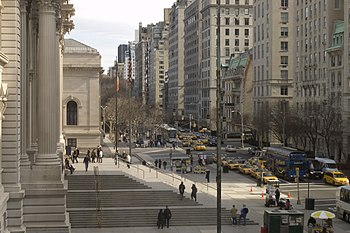5th Avenue (Manhattan)

The Museum Mile section of Fifth Avenue at the Metropolitan Museum of Art at 81st Street
|
|
| Other name(s) | Museum Mile |
|---|---|
| Owner | City of New York |
| Maintained by | NYCDOT |
| Length | 6.2 mi (10.0 km) |
| Location | Manhattan, New York City |
| South end | Washington Square North in Greenwich Village |
| Major junctions |
Madison Square in Flatiron Grand Army Plaza in Midtown Duke Ellington Circle in East Harlem Marcus Garvey Park in Harlem Madison Avenue Bridge in Harlem |
| North end |
|
| East |
University Place (south of 14th) Broadway (14th to 23rd) Madison Avenue (north of 23rd) |
| West |
Sixth Avenue (south of 59th) Central Park-East Drive (59th to 110th) Lenox Avenue (north of 110th) |
| Construction | |
| Commissioned | March 1811 |
Fifth Avenue is a major thoroughfare going through the borough of Manhattan in New York City, United States. It stretches from West 143rd Street in Harlem to Washington Square North at Washington Square Park in Greenwich Village. It is considered among the most expensive and best shopping streets in the world.
The lower stretch of Fifth Avenue extended the stylish neighborhood of Washington Square northwards. The high status of Fifth Avenue was confirmed in 1862, when Caroline Schermerhorn Astor settled on the southwest corner of 34th Street, and the beginning of the end of its reign as a residential street was symbolized by the erection, in 1893, of the Astoria Hotel on the site of her house, later linked to its neighbor as the Waldorf–Astoria Hotel (now the site of the Empire State Building). Fifth Avenue is the central scene in Edith Wharton's 1920 Pulitzer Prize winning novel The Age of Innocence. The novel describes New York's social elite in the 1870s and provides historical context to Fifth Avenue and New York's aristocratic families.
Originally a narrower thoroughfare, much of Fifth Avenue south of Central Park was widened in 1908, sacrificing its wide sidewalks to accommodate the increasing traffic. The midtown blocks, now famously commercial, were largely a residential district until the start of the 20th century. The first commercial building on Fifth Avenue was erected by Benjamin Altman who bought the corner lot on the northeast corner of 34th Street in 1896, and demolished the "Marble Palace" of his arch-rival, A. T. Stewart. In 1906 his department store, B. Altman and Company, occupied the whole of its block front. The result was the creation of a high-end shopping district that attracted fashionable women and the upscale stores that wished to serve them. Lord & Taylor's flagship store is still located on Fifth Avenue near the Empire State Building and the New York Public Library.
...
Wikipedia
